Super Bowl XII - Dallas Cowboys vs Denver Broncos: Pregame
Labor peace for five years was achieved in the NFL before the 1977 season.
- The National Football League Players Association (NFLPA) and the league agreed to a five-year contract .
- The players received increases in minimum salaries and more money for preseason and postseason game as well as improved insurance, medical, and dental benefits.
- The NFLPA agreed to a no-strike, no-suit clause and the continuation of the college draft through 1986.
On the playing field, two rules changes benefited the offenses particularly in the passing game.
- To the great relief of offensive linemen, the head slap was outlawed.
- Another change prohibited DBs and LBs from hitting receivers more than once.
- As somewhat of a compensation for the secondary, WRs could no longer clip defensive players even in the zone around the line of scrimmage where crackback blocks had been allowed.
Another change involved 1976's two expansion teams switching conferences.
- Tampa Bay moved from the NFC West to the NFC Central while Seattle took the Bucs' place in the AFC West.
- Tampa won two games - two more than in their maiden season - and the Seahawks improved from two wins to five.
The Steelers and Raiders had dominated the AFC in the three seasons 1974-75-76.
- In fact, the AFL or AFC champions had won eight of the last nine Super Bowls, the only exception being Dallas's victory over Miami in Super Bowl VI.
- Pittsburgh and Oakland were expected to vie for the AFL title again in 1977.
- However, the upstart Broncos came from nowhere to win the AFC West and defeat both the Steelers and Raiders in the playoffs
Denver's rise to the top of the AFC began with the hiring of a new coach.
- Despite going 9-5 in '76, John Ralston was fired after five seasons produced only 34 victories in 70 games.
Ralston had taught the Dale Carnegie course ("How to Win Friends and Influence People") for 13 years in the off-season. But his approach didn't work with the Broncos. At the end of the season, a dozen players drafted an anti-Ralston statement that got him fired. DE Lyle Alzado, the leader of the mutineers, said, "When we were on the field and looked to the sidelines for leadership, there was nobody to give it. Our coach was running up and down the sidelines cheerleading."
- The new head man was the offensive coordinator of the New England Patriots, Robert "Red" Miller, who had been an assistant in pro football for 17 years, including a stint in Denver in the '60s.
Since his predecessor had been driven out by constant bitching, Miller said, "I appointed a bitch coach. It's Randy Grandishar, our linebacker. I want them bitching to improve during the week. If they're not complaining about something, something's wrong."
- Realizing that the strength of his new team was its defense, Miller kept D-coordinator Joe Collier, architect of the 3-4 defense.
Collier explained the origin of the 3-4. "One year we lost Lyle Alzado on the first play of the first game with a knee injury, so we decided to switch over to the 3-4. We had more good LBs than we had lineman. We had been playing the 3-4 a little bit, but now we went to it full-time. We put in more variations and the players played it for a while. You could just see it coming together. The key was that we kept that group together."
- Red crafted a ball-control offense built around 13-year veteran QB Craig Morton, newly-acquired from the Giants.
- Excited by the new coach and QB, Denver's long-suffering fans, longing for the club's first championship of any kind in its 17-year existence, responded with an enthusiasm that quickly became dubbed as "Broncomania." With Mile High Stadium's capacity increased from 63,500 to 75,087, fans gobbled up tickets at a record pace. The capacity crowds that made more noise than ever before became a force disrupting the opponent's offense and inspiring the home team on both sides of the ball. Denver fans held up a big finger to the world, although it wasn't the usual one. It was a big orange finger indicating the Broncos were #1.
- The Broncos won their first six games for the first time in franchise history. Included was a 30-7 thumping of the defending Super Bowl champs from Oakland on what the governor proclaimed as "Orange Sunday." The 3-4 Orange Crush defense intercepted Ken Stabler a record seven times to end Oakland's 17-game winning streak and hand the Raiders their first loss in Denver since 1962.
- Two weeks later, however, the Black and Silver gained revenge at home with a 24-14 victory that was not as close as the score indicates.
- The Broncos didn't lose again until the final game of the season after they had clinched the #1 seed in the AFC the previous week thanks to Oakland losses to the Chargers and Rams. They rested a number of players against the Cowboys, who also had clinched the other #1 seed. Dallas won the lackluster contest 14-6.
Years later, Miller recalled his first Denver squad. "I took over a team of individuals. They had revolted against Ralston. If I did one thing for that team, I made them a team. I taught them to fight for one another. Well, they did that We didn't have all that much talent ... they played hard." As for his QB, "The first thing I did when I got the job that year was make a trade with the Giants for Craig Morton. Craig didn't have much left in the way of knees, but he still had an arm. He could throw the hell out of the ball." On the Orange Crush defense: "They fought like a bunch of alley cats."
Alzado: "Red drew the team together in a hard time. He gave us discipline. I remember the first meeting we had after he was named coach. All of us came slopping into the meeting room drinking soda pop or eating candy bars like we always had. Red just looked at us and said, 'This is a working room, not a dining room. Don't ever let me see you come in here again eating or drinking. And I mean it!' Nobody ever did, either."
Morton: "What we did in Denver that year was relaxed and enjoyable. And Red was the reason we felt good about what we were doing. He got us believing in ourselves, believing in each other."
The first round of the playoffs produced a third Denver-Oakland clash, this time for the AFC title.
- The Broncos hosted Pittsburgh, a team they had defeated at home 21-7 in Week 8. However, many "experts" expected the playoff-seasoned Steelers to turn the tables this time. But the Broncos scored their first playoff victory ever, 34-21.
The game is best remembered for a sequence of events leading into halftime. In the final minutes of the second period, Pittsburgh DT Joe Greene punched offensive linemen on two successive plays. However, the officials saw only the second infraction. As he left the field at halftime, Coach Miller accosted the officials but not punishing Greene sufficiently. He then yelled at Steeler coach Chuck Noll and D-line coach George Perles in the hallway between the two locker rooms. Their coach's passionate defense of his "family" endeared him to his players even more.
- Meanwhile, the Raiders had to travel across the continent to face the Baltimore Colts. The back-and-forth game found the visitors trailing by three points with less than two minutes left. Facing third down on his own 30, Stabler connected with TE Dave Casper over the middle for 42y. The play has been known ever since as "Ghost to the Post" in honor of Dave's nickname. That enabled Oakland to send the game into OT with a FG. Neither team scored during the first 15 minutes. But at the beginning of the second extra period, Casper caught a 10y pass for the winning TD to give the Raiders their first road playoff victory in their history.
A week later, the 18° temperature couldn't dampen the enthusiasm of the hearty Denver fans enjoying the franchise's first conference championship game ever.
- Craig Morton left his hospital bed to play in pain with injuries to his hip and other joints and muscles. He started the scoring by connecting with WR Haven Moses, who escaped the tackle of the CB and raced into the EZ to complete the 74y play. Later in the first half, Oakland lost All-Pro WR Fred Biletnikoff because of a dislocated shoulder.
- A third period play that lives in infamy in Raider annals and produced an outcry for instant replay helped the Broncos double their lead. On first-and-Goal from the 2, Denver RB Rob Lytle took a handoff on a dive play. S Jack Tatum smashed the ball carrier so hard at the line of scrimmage that the ball came loose. DT Mike McCoy recovered the ball, got up and ran for the opposing goal line. But the officials blew the play dead and ruled that Lytle's forward progress was stopped prior to the fumble. TV replays showed that was not the case. Given another chance, the Broncos scored from the 1 to take a 14-3 lead.
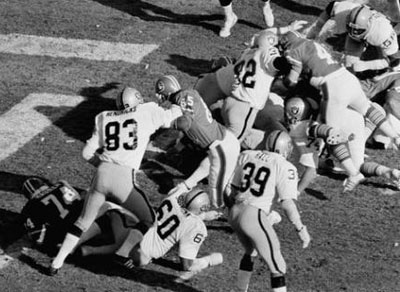
Jack Tatum hits Rob Lytle, causing the fumble that wasn't.
- The teams traded TDs in Q4 before the Raiders scored again to pull within 20-17 with 3:08 on the clock. Inspired by the sea of Orange-clad fans, Denver kept the ball on the ground and ran out the clock. Jubilant Broncos carried Miller off the field on their shoulders while fans tore down the goalposts.
Denver's nine-year veteran S Billy Thompson rejoiced. "Everybody said it would be a cold day in hell if the Broncos got into the playoffs. Everybody said it would be a cold day in hell if we won a game in the playoffs. Everybody said it would be a cold day in hell if we got to the Super Bowl. Well, we made the devil wear an overcoat."
Broncomania reached a fever pitch all across the Rocky Mountains. Sale of Orange Crush T-shirts and windbreakers surpassed the 300,000 mark.
The NFC did not produce a surprise victor.
- Planning for the 1977 NFL Draft, Dallas GM Tex Schramm had his eyes set on one player that he considered the missing component his club needed to return to the Super Bowl. That player was Tony Dorsett of Pittsburgh, the most outstanding RB since O.J. Simpson. But Tex knew the Heisman trophy winner would be long gone by the time his team drafted. So he traded his first round pick and four second rounders to Seattle to move up to #2 and select Dorsett.
- The move paid off in spades as Tony gained 1,007y on the ground and another 273 in receptions to win the Rookie of the Year award.
QB Roger Staubach: "Getting Dorsett was a real shot in the arm. This guy was a sensational player. He had speed, and he was tough, could run inside. He took a lot of the pressure off me. With him we had a very balanced game."
Dallas VP of player personnel Gil Brandt: "Dorsett was a cinch pick. Everybody said he's not very big, but nobody ever hit him square."
RB Preston Pearson: "Tony was the first Cowboys player to get $1 million, but that didn't bother me at all. And quickly Tony showed us he was special. ... We were a machine, and Tony was the game-breaking piece that we needed. He could turn a game around at any point at any time with just one quick hit up the middle."
- The defense underwent enough changes to be rechristened Doomsday II. OLB Bob Breunig moved to the middle to replace Lee Roy Jordan, who retired. Thomas "Hollywood" Henderson filled Breunig's shoes at OLB. Randy White took over one tackle spot, pushing veteran Larry Cole into a backup role. Second-year CB Aaron Kyle was the only new starter in the secondary.
White recalled: "Lee Roy Jordan retired after the 1976 season and in my third year I was expected to become the MLB. But they decided that Bob Breunig was more suited for MLB, so they moved me to OLB. The trouble was that in practice I'd be the weak-side LB covering our rookie, Tony Dorsett, one-on-one out of the backfield. ... I tried hard and worked hard, but I was never comfortable. Then Tom Landry called me into his office and said, "Randy, we're going to move you to defensive tackle." So White gained 20 pounds to play at 265 on the D-line.
- Even with Dorsett not starting until mid-season while he mastered the intricate offense, the Cowboys went 8-0 for the first time in franchise history before losing back-to-back games to the St. Louis Cardinals and Steelers. Then they righted the ship and won their last four, including the finale against Denver, to finish 12-2.
- Tom Landry wanted his teams to peak at the end of the season, and his '77 crew did that splendidly, crushing the Bears and the Vikings in the playoffs by a combined score of 60-13.
The Cowboys were the first team to lead the NFL in both total offense and total defense since the undefeated Dolphins of 1972.
The Broncos, on a Rocky Mountain high, and the Cowboys, making their fourth Super Bowl appearance in eight years, left for New Orleans on Monday.
The Broncos rode to Stapleton Field for their flight through 60,000 fans along downtown Denver streets. 1,000 fans gathered at Love Field in Dallas to bid the Cowboys goodbye.
The Broncos dressed casually for the flight while the Cowboys looked like models in a GQ ad. Hollywood Henderson wore an orange suit that he said he planned to burn.
- Both teams stayed out near the airport far from downtown, Dallas at the Hilton, Denver at the Sheraton. Neither hotel qualified as luxurious accommodations, especially the Sheraton.
The first night of the Broncos stay at the Sheraton, everyone was startled by RB Otis Armstrong sprinting down to the lobby after finding a huge cockroach in his bed. The players complained that paint was peeling off the walls and the food was terrible - in New Orleans, of all places. The McDonald's down the street did a thriving business. Also the elevator broke down once. LB Tom Jackson wrote in his autobiography, "We were beginning to think we might not even make it to the game. The headline would read, '32 Broncos Eaten by Roaches, Rest Lost in Elevator.'"
- New Orleans being an NFC town, the Cowboys were also given the better training facilities. They practiced at the Saints complex not far from their hotel. The Broncos had to ride the bus all the way to Tulane Stadium, which had been abandoned when the Superdome opened.
Veterans of three previous Super Bowls, the Cowboys organization had a small army of people taking care of all non-football matters for the team - getting a car for a player. a plane reservation for his wife, a dinner reservation, or a ticket to the King Tut exhibition at the New Orleans Museum of Art. Seven secretaries were assigned just to the French Quarter.
The contrast between the teams is illustrated by a story told by Denver LB Tom Jackson: "On Thursday night, Billy Thompson and I were watching TV ... Irv Cross was live from Pat O'Brien's, a fairly famous establishment in New Orleans. And he ended the segment with, 'We'll be right back with a few of the Denver Broncos who happen to be here.' It was about 10:15, 10:30 or so. And we're like, O.K., why are guys out? He came back from break and he had three of our offensive linemen sitting there drinking. One of them had on the hard hat where you put a beverage on top and then there's that tube that comes down and around and into your mouth. We were horrified. We said, The Cowboys are watching this! Two Cowboys defensive linemen ended up splitting the MVP."
- Players on both teams shivered as they practiced in the cloudy, cold, damp, and windy weather all week.
A RB on each team received a death threat. A caller to the Hilton warned that Tony Dorsett would not live to finish his first Super Bowl. He was quietly moved to another room just to be safe. Most of the players didn't even know about it until the return flight to Dallas. The target at the Sheraton was Denver RB Jon Keyworth.
Both coaches and QBs faced the press.
- The Denver pair gave a good scouting report on both teams, and both sides addressed the fact that the two QBs were teammates with the Cowboys from 1969 through 1973, when Morton was traded to the Giants. Craig had not beaten the Cowboys when he faced them twice a year with New York.
The two QBs were born on the same day one year apart. Morton was 35, Staubach 34. Roger recalled: "Craig and I came out of college the same year, but I went into the Navy and he became Don Meredith's backup with the Cowboys. When I got to the Cowboys four years later, we competed back and forth for a few years and then I got a chance to be the starter. Craig was really a good quarterback and he was good to me, too. Even when he was playing behind me, he was a great teammate. To this day, our relationship is every positive. We never bickered. When I was the starter, Craig always supported me."
- Miller: "Dallas is not a typical NFC team. They're not conservative at all. ... Dallas was the forerunner in a lot of innovations."
He admitted, "On paper, the Cowboys are a better team than we are, but we've faced that situation all year. What usually happened is that we outplayed teams and beat them. And we have that one big thing going for us in this game: motivation. Winning is in the mind of the player. We're a team of destiny."
Red years later: "I felt good about our chances. We'd won games we weren't supposed to win just to get to New Orleans. We'd played Dallas in the last regular-season game that year, played 'em tough. We lost 14-6."
- Craig Morton agreed with his coach. "NFC teams take a more conservative approach. They're not as wide open as the AFC. Dallas is the exception to that conservative trend. They have superior personnel, they play aggressively, they have that winning edge. Their flex defense is very tough. They do so much from it. Conversely, we're probably one of the more conservative teams in the AFC. If we're backed up to our own goal, percentage-wise we'll run the ball knowing me might have to give it up. Or we'll take a sack rather than risk throwing an interception. We're a patient offense. We know our defense will give us the ball back."
When Morton took the field for Denver's first offensive snap, he became the first QB to start Super Bowl games for different teams.
- Landry defended his handling of his rookie RB, who didn't start the first half of the season. "The most important decision we made this year ... was the handling of Tony Dorsett to be sure that he came along at the proper rate. That was so when he moved, he would move into the lineup very successfully. In the back of the minds of the players is that you have a guy who is that explosive and can score the way Tony can, then he can be a confidence factor for you."
Dorsett recalled: "The Super Bowl was the highlight of my career. ... My senior year in college we won the national championship and I won the Heisman Trophy, and here I was my rookie year going back to the same stadium [where Pittsburgh had beaten Georgia in the Sugar Bowl] playing for a world championship in the National Football League."
- Tom tried to minimize the rivalry between the two QBs. "The decision [to trade Morton] was basically made because of the mobility of Staubach. Actually, I didn't feel it was a crucial decision in that I could win either way. I have great respect for Morton as a QB and as a passer ... Roger perhaps did not have as much experience as Craig did at that time, but he was a guy who could win the ball game for you any time you got in the clutch. Those are hard to come by. ... Craig was probably the one thing Denver needed. They were 9-5 last year, and all they needed was a solid performer at QB. ... The guys up there love him. They believe he is a real factor in their success."
- Staubach also downplayed the rivalry with the Broncos QB. "We have always been friends. I respected him when he was my teammate, and I certainly respect him now." Roger felt that Morton had taken a bum rap by those who made him the goat of the Cowboys' first Super Bowl loss to the Colts in 1971. "Craig was hurt and had to fight back. He had bone chips in his elbow, but he was a great QB for us before he was hurt." Still, Roger admitted feeling extra pressure. "If we lose, everybody's gonna say that Craig should have stayed in Dallas. I have a lot of extra pressure on me because of that."
Dallas S Cliff Harris, who had once tried in vain to scare Lynn Swann out of a Super Bowl, was not so kind in his remarks about Morton. "Craig has a bad hip. I think he won't finish the game. Any time you have a guy hurting, he might not finish the game. With him out, it'll be a different game. I think anybody can be psyched. That's part of my philosophy of football. But Craig knows me. He might be less prone to being psyched."
Harris's remarks led to a rumor that he put out a bounty on Morton for the Super Bowl.
- Morton also praised his counterpart. "Roger is a great QB, and I've always admired him. He's taken a great stand in life, and he has to be admired for that. We fought for the job back then, and he won. But we've both come a long way from there." He was asked about facing his old team. "It's been long enough since I've been there that I don't think I'll have any advantage. I know them, and they know me. So I think it counterbalances. I'm a better QB now. I'm more patient, making less mistakes and not forcing the ball. ... The offensive style of game here is completely different."
Morton talked openly about how his recent marriage had changed his life. "About six months ago I started dating a girl I'd known for many years ... who's a strong Christian, and I've really accepted the Lord through her. I didn't accept the Lord to be a number one QB, I accepted Him for my life." The upcoming game would test Craig's faith to the fullest.
Jimmy the Greek Snyder installed the Cowboys as slight favorites. Snyder gave his reasons in his syndicated column.
- "Denver CB Steve Foley will be under Roger Staubach's gun on Sunday. Look for Staubach to concentrate on Foley's side and stay away from Louis Wright. Drew Pearson, Dallas's main deep threat, can inflict misery on any DB, but Foley rose to the occasion against Oakland's Cliff Branch. Don't think he can't come up with another big game."
- Dallas will enjoy a defensive edge, with its exceptional end Harvey Martin against Bronco T Andy Maurer. If the Cowboys can force Craig Morton into frequent passing situations, Martin can win the car that goes to the MVP. And Denver C Mike Montler will be in for a rough afternoon if he has to help out with White or pass rush specialist Bill Gregory and be on the lookout for the blitz either by a linebacker or safety."
- The Dallas offensive line will have difficulty in springing a ground game against the 3-4 defense of Denver. Veteran T Ralph Neely, closing out 15 years with the Cowboys, will take memories of Lyle Alzado's hard-hitting with him into retirement. John Fitzgerald, the Dallas C who plays hurt most of the time, will have his hands full with Rubin Carter, the quick NT who is the catalyst in the Denver line."
- "All of this adds up to an even situation which suggests that Dallas should be accorded only a slight edge. Dallas by 3."
It was fortunate that the game was played indoors for the first time.
- New Orleans on Super Bowl Sunday 1978 was cold and dreary, continuing the trend of the whole week. The high temperature was in the mid-40s.
- The Superdome opened in time for the 1975 football season. But that was too late for Super Bowl IX, which had to be played in Tulane Stadium in January that year because of construction delays.
- 75,583 spectators would watch the game in comfort.
- Some of the Denver players came out for pregame warmups wearing replicas of the vertical stripe stockings worn by the original Bronco.
- The Southern University band performed before the game, playing "We Shall Overcome" in honor of Dr. Martin Luther King Jr.
Randy White recalled the Dallas locker room before the game. "Everybody was quiet ... Everybody was just sitting there waiting for Coach Landry. At team meetings, Coach Landry was the main talker. Nobody talked when he was talking. But he never gave any big, big pep talks and didn't prior to this game. Hey, if you need the coach to give you a pep talk to get up and play in the Super Bowl, you're in trouble. ... Our confidence level was way up and we just knew when we walked out there to play in the Super Bowl that we were going to win."
White recalled what he saw when the Cowboys entered the field. "It seemed like Denver got most of the tickets to the Super Bowl. Everything in the Superdome seemed to be orange. The Broncos wore orange jerseys and were known as the 'Orange Crush,' so their fans dressed the part. They had orange clothes, orange hair, orange faces."
This was the first Super Bowl to be played in prime time with kickoff at 5:17 PM CST.
- CBS paid $4.5M to telecast the game. Pat Summerall did play-by-play and Tom Brookshier provided commentary. Nick Buoniconti and Paul Hornung served as sideline reporters.
- Hosting The NFL Today coverage before the game were Brent Musburger, Irv Cross, and Phyllis George.
- Viewership was estimated at almost 79,000,000. A 30-second commercial cost $162,000.
- Jack Buck did the radio broadcast for CBS assisted by Jim Kelly and Sonny Jurgensen.
- Phyllis Kelly of Northeast Louisiana University sang the national anthem.
- Gridiron legend Red Grange flipped the coin to determine who kicked off.
The difference between the two clubs was illustrated during the pregame introductions. Instead of following directions - like the Cowboys did - to run up to the camera, pause, then head to the sideline, the Broncos stopped, waited for each other and jumped around like junior high kids playing their first game. The methodical Cowboys noticed this, as S Cliff Harris explained after the game. "We run out, get loose, and get ready to play. We have cheerleaders on the sidelines. They can jump around." Hollywood Henderson added, "We celebrate after the game. The way they acted before the game, all they needed was some skirts and boots, and they would have been all set."
|
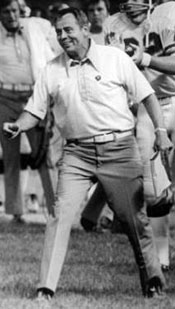
John Ralston
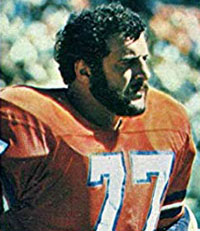
Lyle Alzado
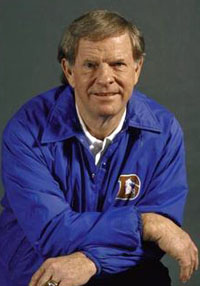
Red Miller
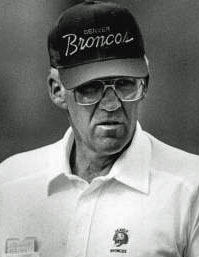
Joe Collier
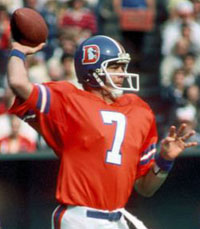
Craig Morton
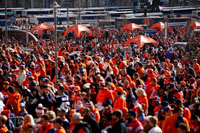
Broncomania
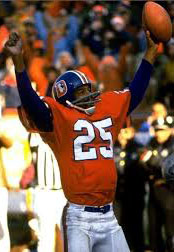
Haven Moses
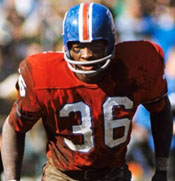
Billy Thompson
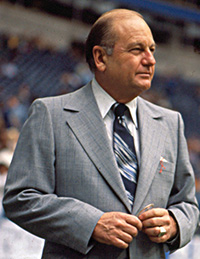
Tex Schramm
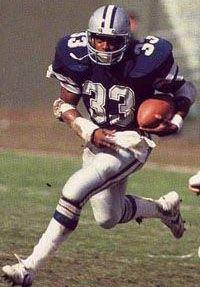
Tony Dorsett

Roger Staubach
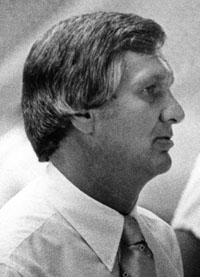
Gil Brandt
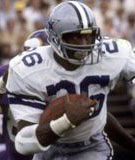
Preston Pearson

Tom Landry
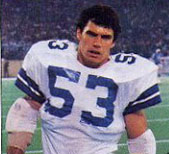
Bob Breunig
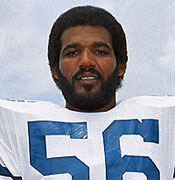
Hollywood Henderson
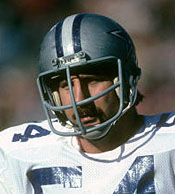
Randy White

Aaron Kyle
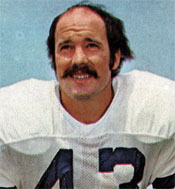
Cliff Harris
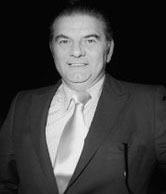
Jimmy the Greek
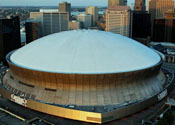
Louisiana Superdome
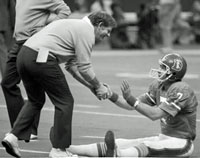
Coach Miller shakes hands with Craig Morton during pregame warmups

Uniform of the original
Broncos in 1960

Tom Brookshier and Pat Summerall
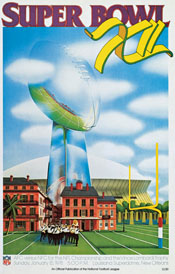
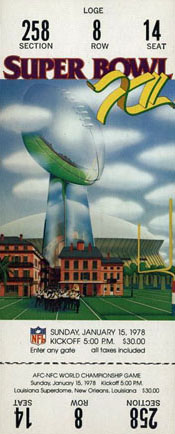
|
1977 Dallas Cowboys
| # |
Player |
Pos. |
Hgt. |
Wgt. |
College |
Exp. |
| 1 |
Efren Herrera |
K |
5-9 |
185 |
UCLA |
4 |
| 11 |
Danny White |
QB |
6-2 |
195 |
Arizona State |
2 |
| 12 |
Roger Staubach |
QB |
6-3 |
195 |
Navy |
9 |
| 18 |
Glenn Carano |
QB |
6-3 |
200 |
UNLV |
1 |
| 20 |
Mel Renfro |
DB |
6-0 |
190 |
Oregon |
14 |
| 25 |
Aaron Kyle |
CB |
5-11 |
185 |
Wyoming |
2 |
| 26 |
Preston Pearson |
RB |
6-1 |
205 |
Illinois |
11 |
| 31 |
Bennie Barnes |
CB |
6-1 |
190 |
Stanford |
6 |
| 33 |
Tony Dorsett |
RB |
5-11 |
190 |
Pittsburgh |
1 |
| 41 |
Charlie Waters |
S |
6-1 |
195 |
Clemson |
8 |
| 42 |
Randy Hughes |
S |
6-4 |
210 |
Oklahoma |
3 |
| 43 |
Cliff Harris |
S |
6-0 |
190 |
Ouachita Baptist |
8 |
| 44 |
Robert Newhouse |
FB |
5-10 |
210 |
Houston |
6 |
| 46 |
Mark Washington |
CB |
5-10 |
190 |
Morgan State |
8 |
| 50 |
D.D. Lewis |
LB |
6-1 |
225 |
Mississippi State |
10 |
| 53 |
Bob Breunig |
LB |
6-2 |
225 |
Arizona State |
3 |
| 54 |
Randy White |
DT |
6-4 |
255 |
Maryland |
3 |
| 56 |
Thomas Henderson |
LB |
6-2 |
220 |
Langston |
3 |
| 57 |
Bruce Huther |
LB |
6-1 |
220 |
New Hampshire |
1 |
| 58 |
Mike Hegman |
LB |
6-1 |
225 |
Alabama A&M; Tenn. St. |
2 |
| 59 |
Guy Brown |
LB |
6-4 |
225 |
Houston |
1 |
| 61 |
Jim Cooper |
G |
6-5 |
260 |
Temple |
1 |
| 62 |
John Fitzgerald |
C |
6-5 |
255 |
Boston College |
7 |
| 63 |
Larry Cole |
DT |
6-5 |
250 |
Air Force; Houston; Haw. |
10 |
| 64 |
Tom Rafferty |
G |
6-3 |
255 |
Penn State |
2 |
| 65 |
Dave Stalls |
DE |
6-5 |
250 |
Northern Colorado |
1 |
| 66 |
Burton Lawless |
T |
6-4 |
255 |
Florida |
3 |
| 67 |
Pat Donovan |
T |
6-5 |
255 |
Stanford |
3 |
| 68 |
Herbert Scott |
G |
6-2 |
255 |
Virginia Union |
3 |
| 70 |
Rayfield Wright |
T |
6-6 |
255 |
Fort Valley State |
11 |
| 71 |
Andy Frederick |
T |
6-6 |
257 |
New Mexico |
1 |
| 72 |
Ed Jones |
DE |
6-6 |
265 |
Tennessee State |
4 |
| 73 |
Ralph Neely |
T |
6-6 |
265 |
Oklahoma |
13 |
| 75 |
Jethro Pugh |
DT |
6-6 |
260 |
Elizabeth City State |
13 |
| 77 |
Bill Gregory |
DT |
6-5 |
255 |
Wisconsin |
7 |
| 79 |
Harvey Martin |
DE |
6-5 |
260 |
Texas A&M-Commerce |
5 |
| 80 |
Tony Hill |
WR |
6-2 |
200 |
Stanford |
1 |
| 83 |
Golden Richards |
WR |
6-1 |
180 |
Hawaii, Brigham Young |
5 |
| 86 |
Butch Johnson |
WR |
6-1 |
185 |
California-Riverside |
2 |
| 87 |
Jay Saldi |
TE |
6-3 |
225 |
South Carolina |
2 |
| 88 |
Drew Pearson |
WR |
6-0 |
185 |
Tulsa |
5 |
| 89 |
Billy Joe Dupre |
TE |
6-4 |
225 |
Michigan State |
5 |
|
1977 Denver Broncos
| # |
Player |
Pos. |
Hgt. |
Wgt. |
College |
Exp. |
| 7 |
Craig Morton |
QB |
6-4 |
215 |
California |
13 |
| 12 |
Craig Penrose |
QB |
6-3 |
210 |
Colorado; San Diego St. |
2 |
| 14 |
Norris Weese |
QB |
6-1 |
195 |
Mississippi |
2 |
| 15 |
Jim Turner |
K |
6-2 |
205 |
Utah State |
14 |
| 20 |
Louis Wright |
CB |
6-2 |
200 |
Arizona St., San Jose St. |
3 |
| 21 |
Randy Poltl |
S |
6-3 |
190 |
Stanford |
4 |
| 24 |
Otis Armstrong |
RB |
5-10 |
195 |
Pursude |
5 |
| 25 |
Haven Moses |
WR |
6-2 |
210 |
San Diego State |
10 |
| 26 |
Larry Riley |
CB |
5-10 |
190 |
Salem |
1 |
| 29 |
Bernard Jackson |
S |
6-0 |
180 |
Washington State |
6 |
| 30 |
Jim Jensen |
RB |
6-3 |
230 |
Iowa |
2 |
| 32 |
Jon Keyworth |
FB |
6-3 |
230 |
Colorado |
4 |
| 35 |
Lonnie Perrin |
RB |
6-1 |
220 |
Illinois |
2 |
| 36 |
Bill Thompson |
S |
6-1 |
200 |
Maryland-Eastern Shore |
9 |
| 41 |
Rob Lytle |
RB |
6-1 |
200 |
Michigan |
1 |
| 43 |
Steve Foley |
CB |
6-2 |
190 |
Tulane |
2 |
| 50 |
Bobby Maples |
C |
6-3 |
250 |
Baylor |
13 |
| 51 |
Bob Swenson |
LB |
6-3 |
225 |
California |
3 |
| 52 |
Mike Montler |
C |
6-5 |
255 |
Colorado |
9 |
| 53 |
Randy Grandishar |
LB |
6-3 |
235 |
Ohio State |
4 |
| 55 |
Godwin Turk |
LB |
6-3 |
230 |
California, Southern |
3 |
| 56 |
Larry Evans |
LB |
6-2 |
215 |
Mississippi College |
2 |
| 57 |
Tom Jackson |
LB |
5-11 |
220 |
Louisville |
5 |
| 58 |
Rob Nairne |
LB |
6-4 |
225 |
Oregon State |
1 |
| 59 |
Joe Rizzo |
LB |
6-1 |
220 |
Kings Point |
4 |
| 60 |
Paul Howard |
G |
6-3 |
260 |
Brigham Young |
5 |
| 62 |
Tom Glassic |
G |
6-3 |
255 |
Virginia |
2 |
| 63 |
John Grant |
DT |
6-3 |
240 |
USC |
5 |
| 65 |
Glenn Hyde |
T |
6-3 |
255 |
Pittsburgh |
2 |
| 66 |
Brison Manor |
DE |
6-4 |
245 |
Arkansas |
1 |
| 67 |
Steve Schindler |
G |
6-3 |
255 |
Boston College |
1 |
| 68 |
Rubin Carter |
NT |
6-0 |
255 |
Miami (FL) |
3 |
| 70 |
Paul Smith |
DT |
6-3 |
255 |
New Mexico |
10 |
| 71 |
Claudie Minor |
T |
6-4 |
280 |
San Diego State |
4 |
| 73 |
Henry Allison |
T |
6-3 |
255 |
Col.of Sequoias; SDSU |
7 |
| 74 |
Andy Maurer |
T |
6-3 |
265 |
Oregon |
8 |
| 77 |
Lyle Alzado |
DE |
6-3 |
255 |
Yankton |
7 |
| 79 |
Barney Chavous |
DE |
6-3 |
250 |
South Carolina State |
5 |
| 80 |
Rick Upchurch |
WR |
5-10 |
175 |
Minnesota |
3 |
| 82 |
Jack Dolbin |
WR |
5-10 |
180 |
Wake Forest |
3 |
| 85 |
Ron Egloff |
TE |
6-5 |
230 |
Wisconsin |
1 |
| 86 |
John Schultz |
WR |
5-10 |
180 |
Maryland |
2 |
| 88 |
Riley Odoms |
TE |
6-4 |
230 |
Houston |
6 |
|
References: Journey to Triumph: 110 Dallas Cowboys Tell Their Stories, Carlton Stowers (1982)
The Super Bowl: Celebrating a Quarter-Century of America's Greatest Game (1990)
Super Bowl Chronicles: A Sportswriter Reflects on the First 30 Years of America's Game, Jerry Green (1995)
Super Bowl: The Game of Their Lives, Danny Peary (ed.) (1997)
The Football Game I'll Never Forget: 100 NFL Stars' Stories, selected by Chris McDonell (2004)
Stadium Stories: Denver Broncos - Colorful Tales of the Orange and Blue, Larry Zimmer (2004)
Landry's Boys: An Oral History of a Team and an Era, Peter Golenbock (2005)
Game of My Life Dallas Cowboys: Memorable Stories of Cowboys Football, Jean-Jacques Taylor (2006)
The Ultimate Super Bowl Book, Bob McGinn (2009)
Staubach: Portrait of the Brightest Star, Carlton Stowers (2005)
The Dallas Cowboys: The Outrageous History of the Biggest, Loudest, Most Hated, Best Loved Football Team in America,
Joe Nick Patoski (2013)
50 Years, 50 Moments: The Most Unforgettable Plays in Super Bowl History, Jerry Rice and Randy O. Williams (2015)
Super Bowl Gold: 50 Years of the Big Game, Sports Illustrated (2015)
The Super Bowl: The First Fifty Years of America's Greatest Game, David Fischer (2015)
The NFL in the 1970s: Pro Football's Most Important Decade, Joe Zagorski (2016)
The First 50 Super Bowls: How Football's Championships Were Won, Ed Benkin (2018)
|
|

























